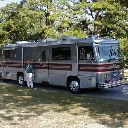Go to...  | Start A New Topic  | Search  | Notify  | Tools  | Reply To This Topic  |  |
Being new and not having been out yet with our 91 regency I feel real stupid. Is there a rule of thumb as to when you should put the coach on the levelers. Right now and for the next 3-5 days it is at our business,and I have this feeling it should not just be sitting there. Too I have not found within all the books and records we received with the unit a so called BARTH operation mauual. Any help is welcome. Dale | |||
|
| First Month Member |
If the coach is standing still with the fridge running, it needs to be fairly level. Check your manual, as numbers will vary with make and model. FWIW, my late Norcold calls for being within 3 degrees from level left to right, and 6 degrees fore and aft. You might shop the RV catalogs for a little set of levels to mount near the controls for your jacks. | |||
|
Bill's right... the only reason you need to worry about (relative) level is the fridge... when they are running you need it level to keep bubbles from getting stuck in the ammonia coils. They are rather expensive to replace. When you are driving down the road the fridge moves around with the coach so much that bubbles can't get trapped, so, it's OK. I have a small bubble level that I use, and I use it to level the freezer plate (shelf), fore and aft , left and right. | ||||
|
Hey guys, any advantage or reason to use the jacks when parking the coach for a while? (30 days) | ||||
|
 |
Conversely, any reason to NOT use hydraulic levelers when stored for extended time? | |||
|
| First Month Member |
Caution: Boring, general answer follows. Barths are pretty solid, but every structure likes to be stored in the position in which it was assembled (ie: on a flat surface). If it is not at least on a flat surface, the chassis will be twisted and one spring will have more or less compression than its counterpart on the other side. Anti-sway bars will be tweaked, etc. There is a thing called "modulus of elasticity", which relates to the ability of a piece of metal to return to its original shape after being flexed. The duration of the deformation enters (but only mildly) into this consideration. Things could take a "set". A diesel with air bags would be less of a problem than a gasser. I had a Southwind that pertially popped its windshield when the frame flexed. | |||
|
 8/09 8/09 |
yes, but it was a Southwind. All kidding aside, what Bill says makes eminent good sense and storage, whether short or long term, is best for coach and people on a relatively level surface or leveled by means of blocks or system. I wouldn't leave jacks down for a long time in case one should get stuck but each to his or her own. It is good to get some of the weight off the tires if sitting in one spot a long time..... | |||
|
 4/08 4/08"5+ Years of Active Membership" |
If I was going to leave my coach sitting for a while, I would not use the jacks. Leaving the cylinder rams out and exposed for a long period will allow corrosion and ultimately affect the seals when retracted. If the coach is not level it is better to pull it onto wooden blocks to achieve a relatively level position for that duration of time ------------------ William B. Goodwin | |||
|
| First Month Member |
LPS3 is a great product for protecting exposed metal. I live near the ocean, and am always fighting corrosion from salt air. Of course, the best thing for a motor home is to drive it once a month. Tires, engine, trans, steering, brakes, everything. When I bought my Barth, it had 9 year old tires on it. They looked perfect, probably because it git driven weekly. The previous owners had to move it for street sweeping once a week. They always brought it to operating temp before parking it again. | |||
|
| Powered by Social Strata |
| Please Wait. Your request is being processed... |
|
This website is dedicated to the Barth Custom Coach, their owners and those who admire this American made, quality crafted, motor coach.
We are committed to the history, preservation and restoration of the Barth Custom Coach.
We are committed to the history, preservation and restoration of the Barth Custom Coach.

